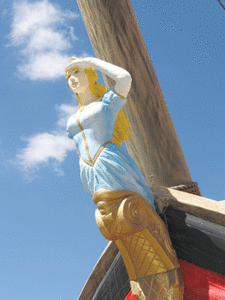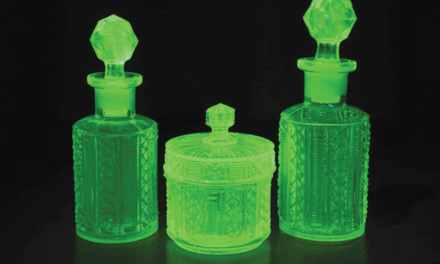
A pleasing, beautifully carved women was meant to be a tantalizing sight for gods of the sea, who might find favor in the woman at the front, and let the ship pass along the sea unharmed. (Photo courtesy DeeDee Wood)
Collectors in the nautical antiques market love to obtain a ship’s figurehead.
The figurehead of a ship is the carved wooden decoration, usually a person or deity, found at the bow of the ship, designed in relation to the name or idea of the ship.
Ship figureheads were popular between the 16th and 20th centuries, and had a special role in maritime history.
Some of the earliest ships to sail our world’s oceans had some sort of figurehead as a fixture at the bow — often as protection or symbolism of might.
The Greeks carved boar heads or wolves to symbolize their ferocious nature, and Romans put carvings of deities for protection at their bows.
Even earlier, the Egyptians used holy animals and the Phoenicians used horses, to represent speed.
Northern Europe produced some wonderful figureheads for their ships in the 13th century.
Bulls, dolphins, dragons and serpents were all used to show courage, strength, agility in the water, protectiveness and a fierce fighting nature.
Many of these very old figureheads, if they survived, would mainly be in museums of maritime history.
Germany, Belgium and other countries in that particular region of the world, such as the Netherlands, believed in Kaboutemannekes, or spirit guardians on the bows of their ship.
They believed in gnomes and faeries, and they also believed the spirits of these magical beings could dwell in the figureheads and protect the ships.
If the ship sank, these sailors from this region believed that the souls of the sailors would be guided to the afterlife by these spirits.
Similar stories come out of the Scandinavia region and the Vikings.
The 17th and 18th century saw subject matter of the figurehead changing, representing more patriotic tones, saints, lions and unicorns (to represent the might and power of England, a rising maritime strength in the military), and royal or naval terms.
Sometimes the figureheads became very heavy and weighed several tons, often times weighing the ship down, and having twin figures on either side of the bow.
Many sailors from old maritime days could not read, or were semi-illiterate, so the figurehead was also a way to visually identify a ship without having to read the name of the vessel.
Identification and representation were important to ships back in long-voyage sailing days, when traversing the globe in an uncertain territory or unchartered waters could not only be dangerous, but also mystical and otherworldly.
Having a protective symbol that was so recognizable on the bow of the ship must have brought comfort to the weary traveler.
Scantily clad women were also used and represented in figurehead construction, not because it appealed to sailors on board, as having a woman on a ship was considered back luck and superstition was a huge part of the sailor journey on uncharted seas.
The pleasing, beautifully carved women was meant to be a tantalizing sight for gods of the sea — who might find favor in the woman at the front, sometimes depicted as topless or scant clothing — and let the ship pass along the sea unharmed.
The downturn of the figurehead began as engineers of great ships began to realize that the massive wooden, carved ornamentations were weighing the ship down and causing cruising abilities and maneuvering to suffer.
In the late 18th century, with the invention of the military ship, the ornate decoration of the ship was on the decline.
Many ships also began using plaques with their name and designation, further undercutting the use for visual representations of the ship in question, cruising on the seas.
Fanciful ideas of protection and spirits were replaced with practical sense and military order.
Ship design also changed, causing straight, modern hauls not to have room for a large figurehead on the bow.
Antique collectors can still find wooden, original figureheads off of ships, going for big dollars in auctions, or buying replicas of a bygone era.
Those who collect nautical antiques enjoy the history, stories and ship representation from a time when the world was exploring the seas, untouched and unknown.
(Editor’s note: DeeDee Wood is the owner of Black Cat Curiosities Art and Antiques in Easton, Md., located at 24B Harrison St.)




